Mount St. Helens, a majestic symbol of Washington State, USA, is not only a famous volcano but also a living testament to nature’s destructive power and miraculous resilience. The historic eruption in 1980 profoundly marked the landscape, transforming this area into a unique destination for those passionate about exploring and understanding the natural world. Join “Du lịch khắp thế gian” (Travel Around the World) to discover the best experiences for visiting Mount St. Helens National Volcanic Monument, ensuring you have a fulfilling and memorable journey.
Introducing Mount St. Helens National Volcanic Monument
Established in 1982, just two years after the catastrophic eruption, Mount St. Helens National Volcanic Monument was created to preserve the unique natural landscape and facilitate scientific research, education, and tourism. Located in the majestic Cascade Range, within Washington State, the monument spans over 445 km², encompassing Mount St. Helens volcano, the area directly impacted by the eruption, and the surrounding recovering region.
With diverse terrain ranging from rugged volcanic craters and pristine lakes to vigorously regenerating forests, Mount St. Helens offers rich and surprising travel experiences. Visitors here not only witness the wild, magnificent beauty but also have the opportunity to learn about volcanic formation, the impact of the eruption, and the remarkable recovery of the ecosystem. It is truly an ideal destination for those seeking to immerse themselves in nature and discover the wonders bestowed by creation.
Formation History and the Catastrophic 1980 Eruption
Mount St. Helens is a geologically young volcano, formed approximately within the last 40,000 years, undergoing numerous eruption phases and mountain structure building. Before 1980, the mountain was known for its beautiful snow-capped cone shape, nicknamed “America’s Fuji.” However, this beauty was completely altered by the catastrophic eruption on May 18, 1980.
The event began with a series of earthquakes in March 1980, signaling the awakening of the volcano after more than a century of dormancy. The climax was a 5.1 magnitude earthquake on the morning of May 18th, triggering a massive landslide on the north flank of the mountain. This landslide reduced the pressure inside the volcano, leading to an incredibly powerful lateral eruption.
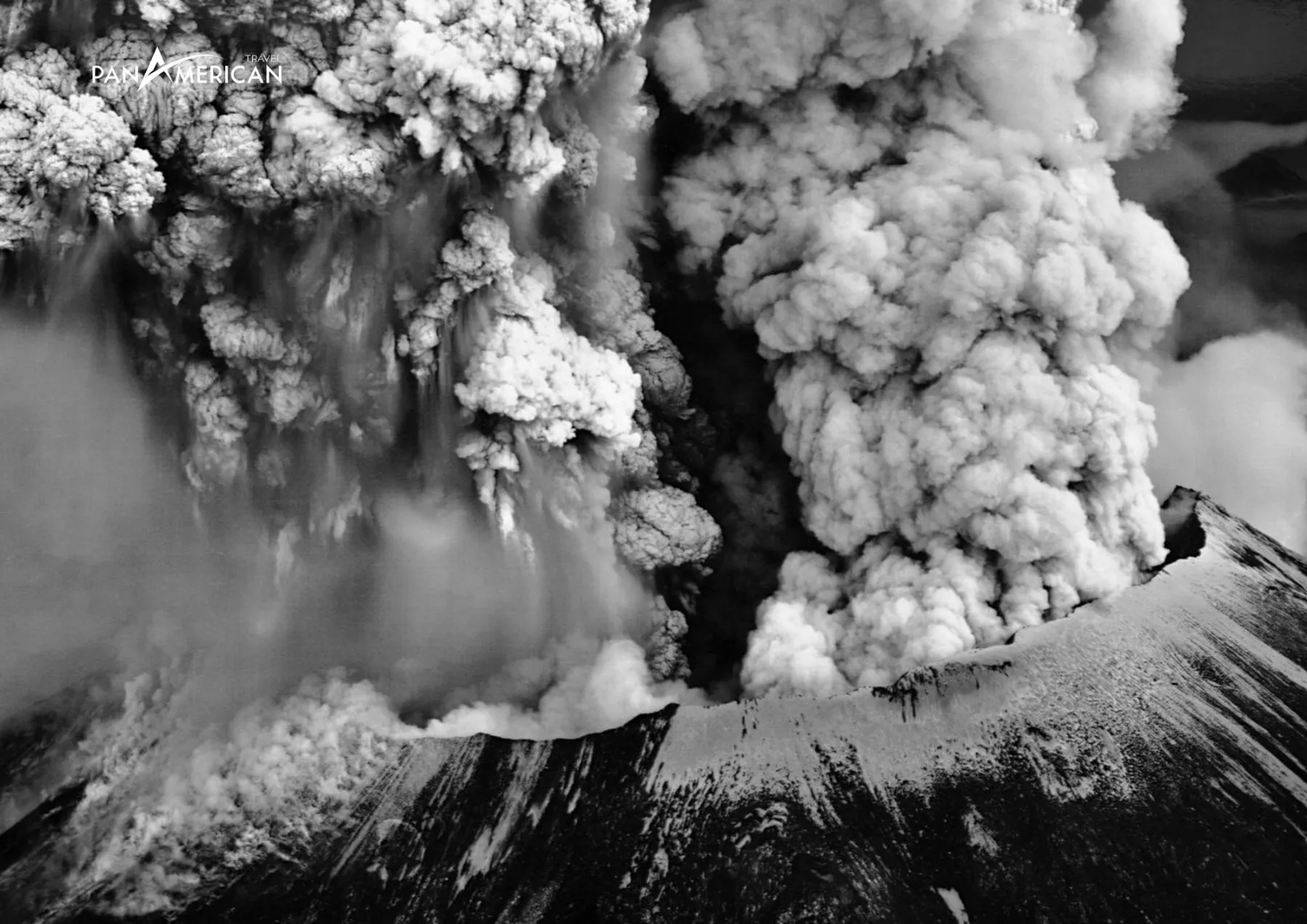
Mount St. Helens eruption on May 18, 1980, the most destructive event in modern history.
The 1980 eruption released energy equivalent to 500 atomic bombs dropped on Hiroshima, devastating everything within a radius of dozens of kilometers. Millions of tons of ash erupted into the sky, covering a vast area and reaching as far as the eastern states. The shockwave and pyroclastic flows (mixtures of hot gas and ash) moved at supersonic speeds, flattening forests, melting snow and ice, and creating massive mudflows (lahars). The eruption claimed the lives of 57 people, destroyed hundreds of homes, and caused severe economic damage.
However, from this terrible destruction, Mount St. Helens became an invaluable natural laboratory, where scientists study ecological recovery and the interaction between volcanoes and the environment. Today, the area around the volcano has vigorously revived, attracting visitors to admire its unique beauty and learn about the power of nature.
Experiences for Visiting Mount St. Helens National Volcanic Monument
Visiting Mount St. Helens National Volcanic Monument offers countless fascinating and memorable experiences. Here are 10 standout destinations and tourist activities you shouldn’t miss:
Johnston Ridge Observatory
Johnston Ridge Observatory is ideally located just about 8km north of the crater, providing the closest and most impressive views of the area devastated by the 1980 eruption. Here, you can admire the massive horseshoe-shaped crater, the desolate valley, and the clear traces of the eruption.
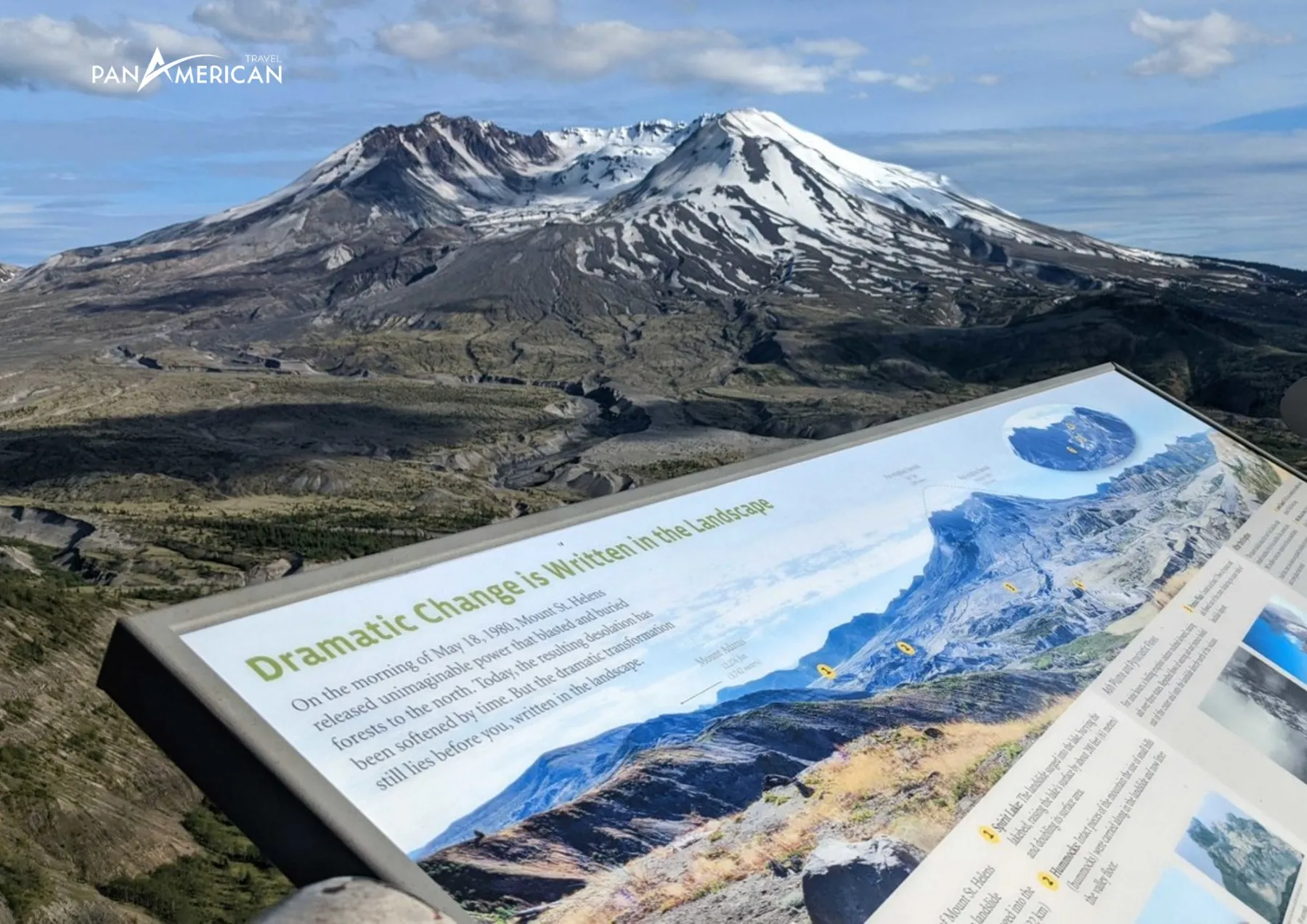
Johnston Ridge Observatory, an ideal destination for panoramic views of the crater and devastated area.
The visitor center at the observatory offers exhibits, models, videos, and vivid images about volcanic history, the 1980 eruption, and ecological recovery. You’ll have the opportunity to learn more about geology, biology, and the impact of volcanoes on the environment. Short walking trails around the observatory also provide beautiful perspectives and opportunities for close-up nature observation.
Visiting Tips:
- Visit in the early morning or late afternoon to avoid harsh sunlight and enjoy the best scenery.
- Bring binoculars to observe the crater and landscape in more detail.
- Check the weather forecast before going and prepare appropriate attire.
Spirit Lake
Spirit Lake was once a beautiful jewel at the foot of Mount St. Helens. However, the 1980 eruption completely changed the landscape here. The massive landslide plunged into the lake, raising the water level and sweeping away all living creatures. Millions of uprooted trees floated on the lake surface, creating a bizarre and haunting scene.
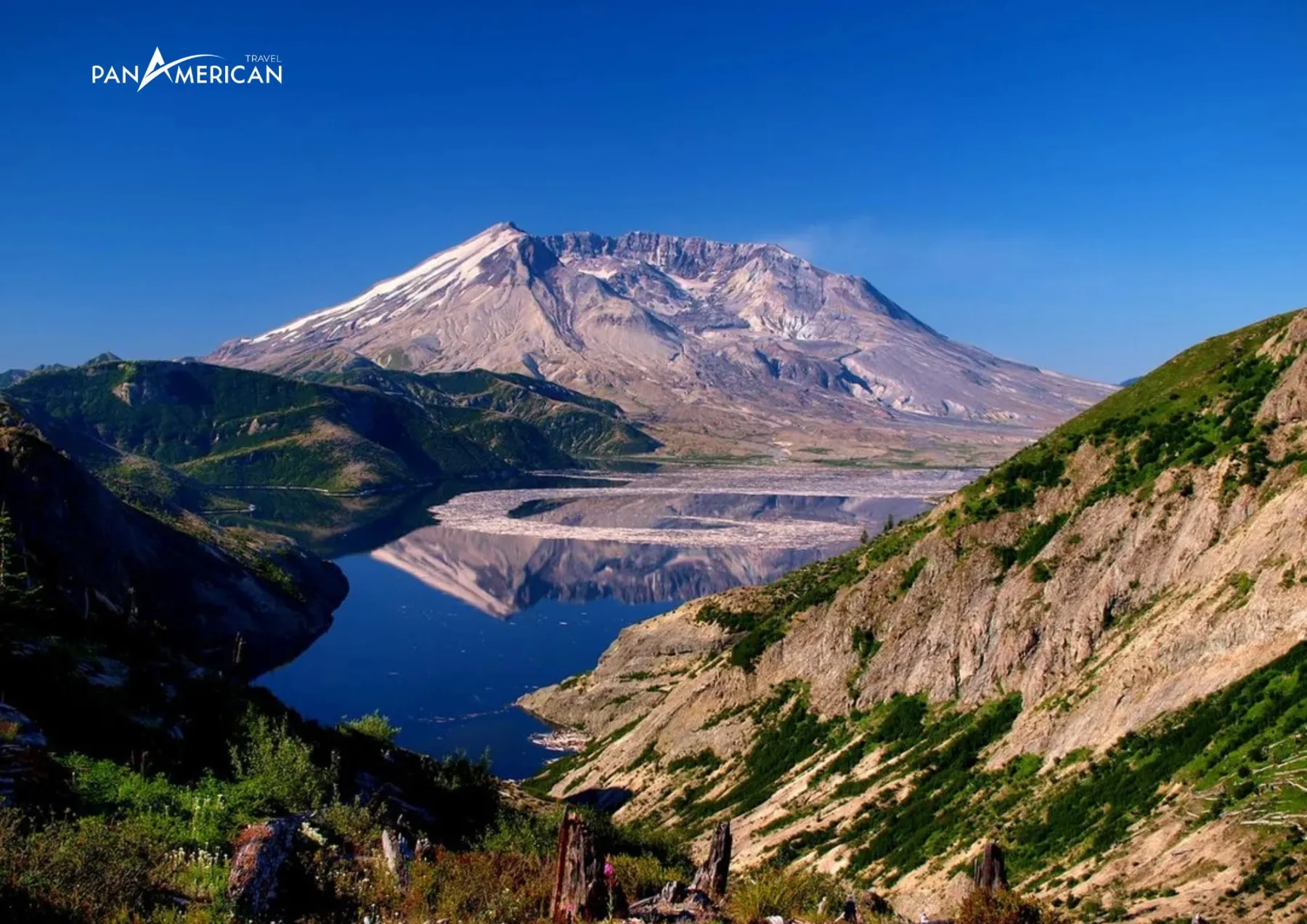
Spirit Lake today, peaceful beauty hiding a story of recovery after disaster.
Today, Spirit Lake has vigorously revived. The lake water has become clear again, reflecting the mountains and sky. Although traces of floating logs remain, Spirit Lake has become a peaceful and enchanting destination. Visitors can enjoy activities such as kayaking, fishing, hiking around the lake, and watching stunning sunsets.
Visiting Tips:
- Rent a kayak or canoe to explore the lake from the water.
- Hike on trails along the lake to enjoy the fresh air and natural scenery.
- Leisure fishing (requires a Washington State fishing license).
- Learn about the history and recovery of Spirit Lake at the nearby visitor center.
Mount St. Helens Visitor Center at Silver Lake
The Mount St. Helens Visitor Center at Silver Lake is the first and ideal stop to begin your exploration of the monument. The center provides an overview of the area, volcanic history, the 1980 eruption, and tourist activities.
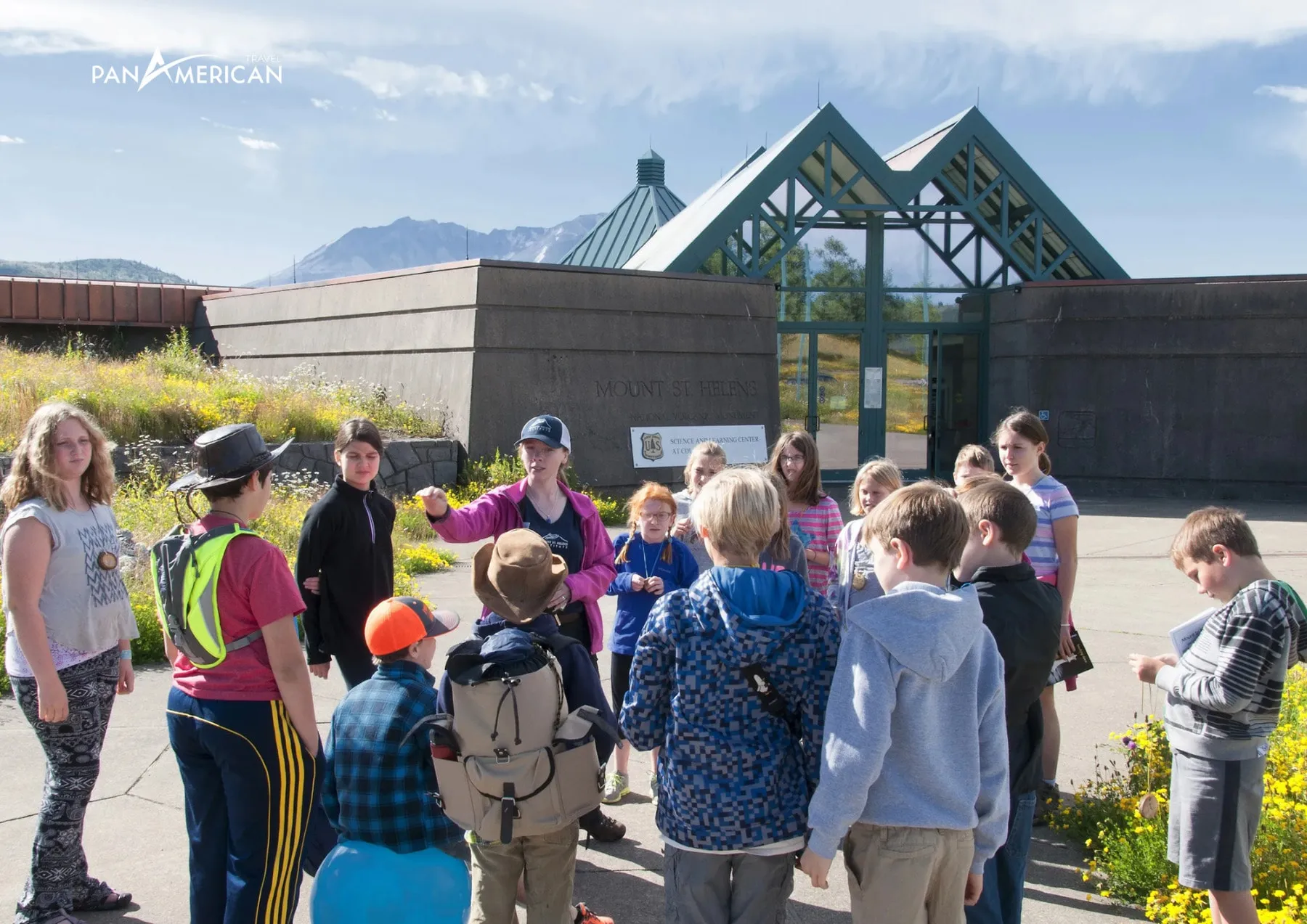
Mount St. Helens Visitor Center, a place to gain knowledge and orientation for your visit.
Exhibits at the center detail the geology, ecosystem, and environmental impact of the eruption. You can watch documentaries, models, and artifacts related to the volcano and the eruption. Friendly and enthusiastic staff will provide information, maps, and helpful advice for effective visit planning.
Visiting Tips:
- Spend time viewing the exhibits and documentaries to better understand Mount St. Helens.
- Get a monument map and information on trails and attractions.
- Ask center staff about weather conditions, trail conditions, and suitable activities.
Ape Cave
Ape Cave lava tube is a unique and fascinating natural wonder located south of Mount St. Helens. With a length of over 3,600 meters, it is the third-longest lava tube in North America. The cave formed about 2,000 years ago when hot lava flowing from the volcano created an underground tunnel.
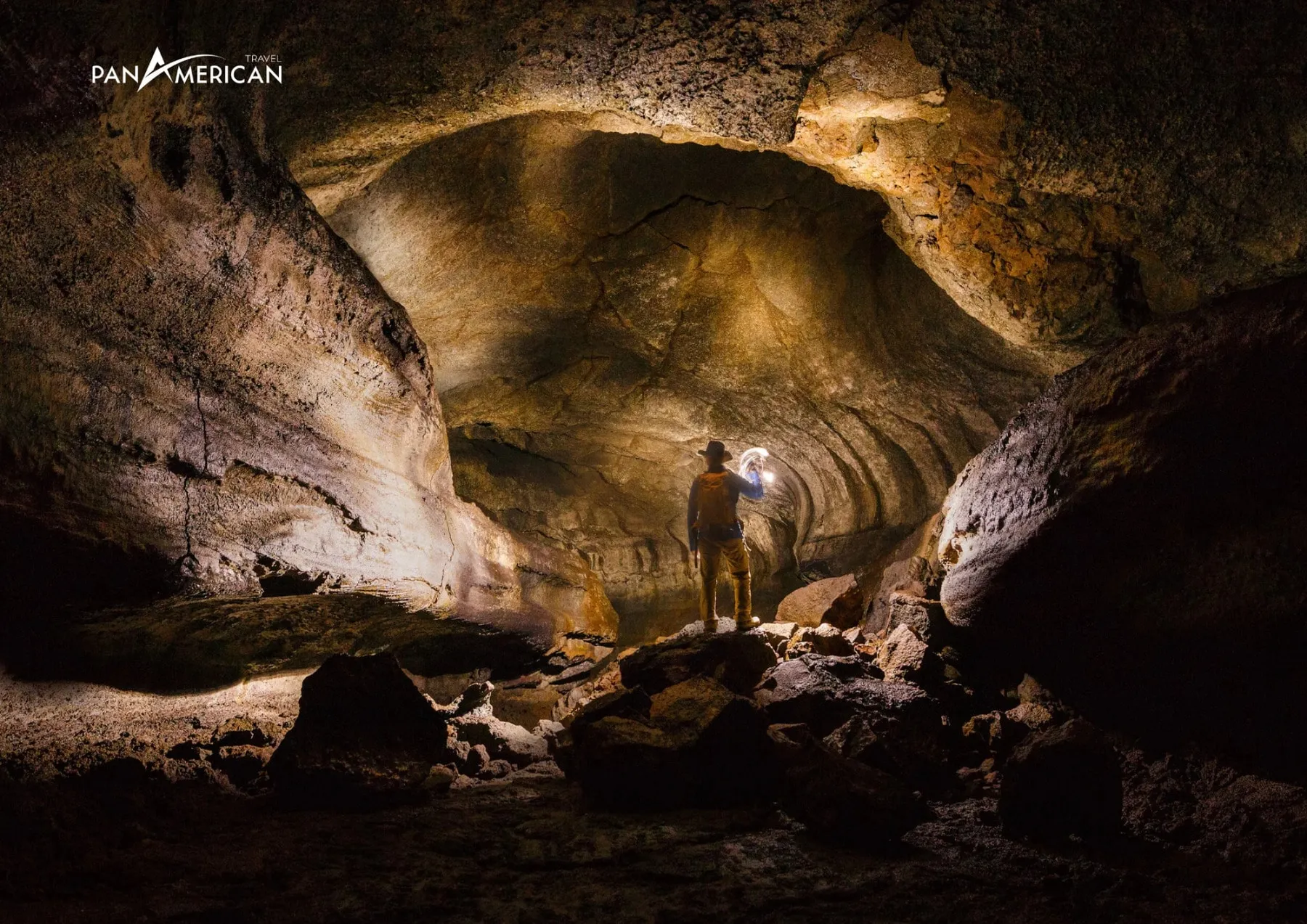
Explore the mysterious beauty of Ape Cave, a unique underground lava tube system.
Exploring Ape Cave is an adventurous and exciting experience. You will walk underground, through narrow and wide cave sections, admiring strange lava rock formations and learning about the cave’s formation process. The cave has a stable temperature of about 7°C year-round, so you need to prepare warm clothes and flashlights for exploration.
Visiting Tips:
- Rent flashlights and helmets at the service center near the cave entrance.
- Wear hiking shoes or athletic shoes with good traction.
- Bring warm clothes and drinking water.
- Follow safety regulations and ranger instructions.
Lava Canyon
Lava Canyon is a geological masterpiece created by meltwater and flash floods after the 1980 eruption. The powerful water flow eroded ash and pumice layers, creating a deep and narrow canyon with vertical cliffs and majestic waterfalls.
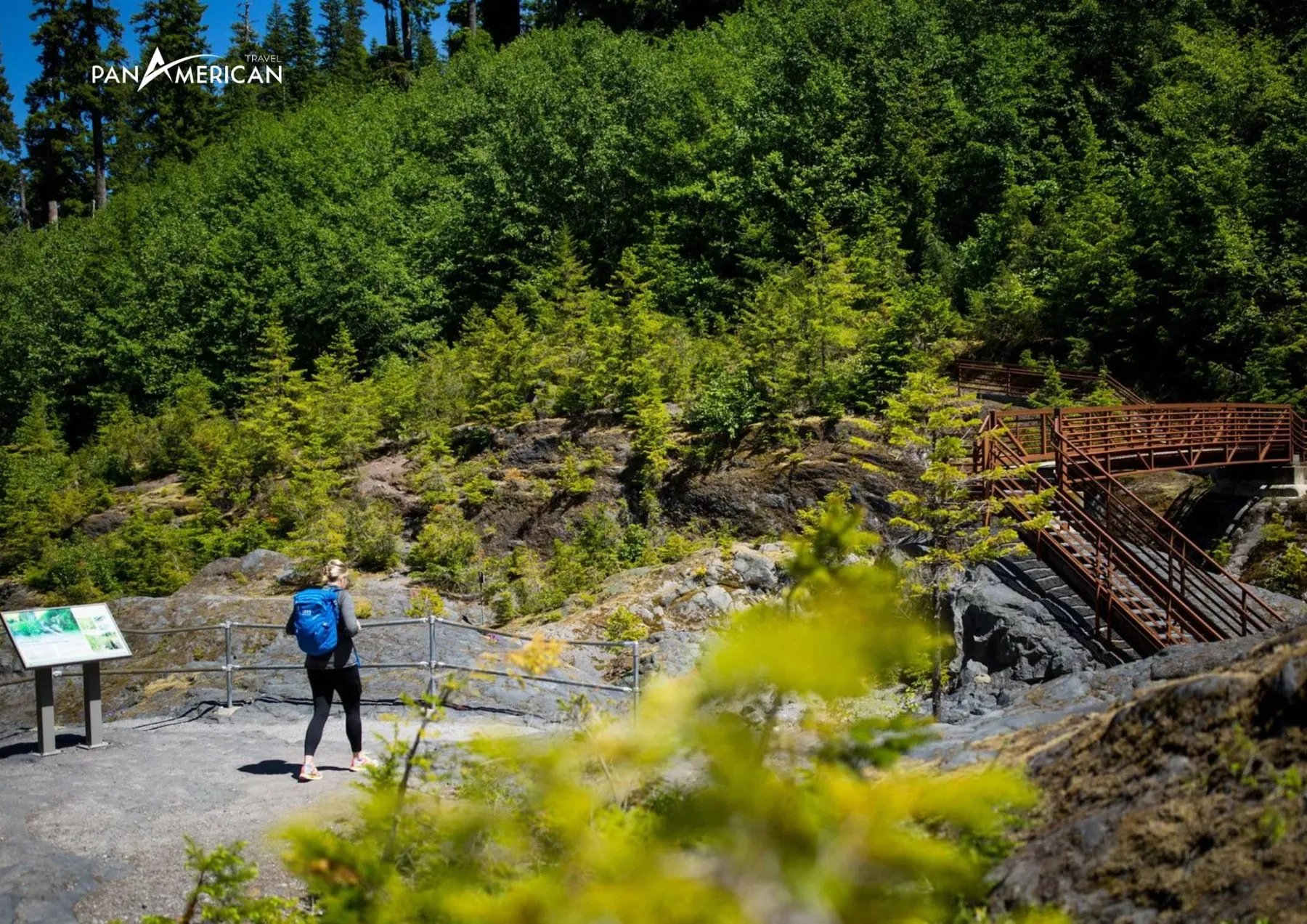
Lava Canyon, where the power of nature is displayed through waterfalls and majestic cliffs.
Walking along trails beside the canyon, you will admire the spectacular scenery of waterfalls, basalt cliffs, and regenerating forests. A suspension bridge across the canyon provides a thrilling experience and stunning panoramic views. Lava Canyon is an ideal destination for those who love hiking and exploring wild nature.
Visiting Tips:
- Hike on clearly marked trails.
- Be careful when walking on the suspension bridge and observe waterfalls from a distance to ensure safety.
- Bring a camera to capture beautiful moments of the canyon.
Windy Ridge Viewpoint
Windy Ridge Viewpoint offers a fantastic panoramic view of Mount St. Helens, Spirit Lake, and the area devastated by the eruption. From here, you can admire the crater, lava flows, and majestic mountain scenery. Windy Ridge is especially beautiful at sunrise and sunset, when sunlight enhances the beauty of the natural landscape.

Windy Ridge Viewpoint, an ideal viewpoint to capture the majestic beauty of Mount St. Helens.
To reach Windy Ridge, you’ll drive on the winding and steep Forest Road 99. However, your reward is one of the most beautiful views in the monument. Windy Ridge is also the starting point for many exciting hiking trails.
Visiting Tips:
- Drive carefully on Forest Road 99, which is narrow and has many curves.
- Arrive early to get parking and enjoy the quiet atmosphere.
- Prepare warm clothes as Windy Ridge is at a high elevation and windy.
Hummocks Trail
The Hummocks Trail takes you to explore the Hummocks area, a unique terrain formed by the 1980 landslide. Thousands of massive rocks and soil from the mountain flank fell into the Toutle River valley, creating a chaotic and bizarre landscape.
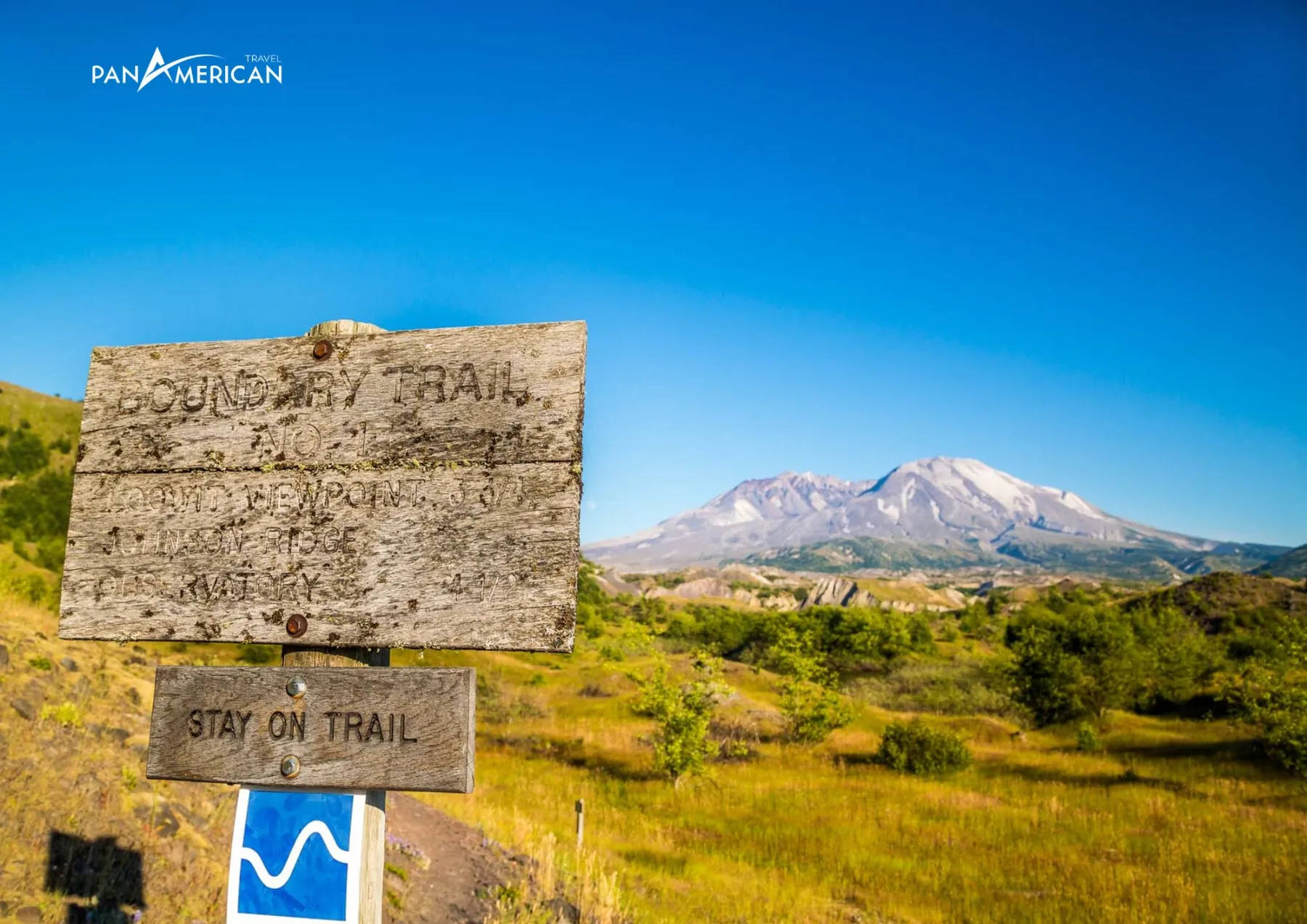
Hummocks Trail, a journey to explore a unique terrain area and a miraculously regenerating ecosystem.
Walking on the Hummocks Trail, you will feel the desolation and destructive power of the eruption. However, you will also witness the strong resurgence of nature. Trees and wildflowers have grown among the debris, and wildlife has returned to inhabit the area. Hummocks Trail is a clear testament to the amazing resilience of the ecosystem.
Visiting Tips:
- Walk slowly and closely observe the unique landscape of the Hummocks area.
- Bring a guidebook or plant identification app to learn about regenerating plant species.
- Pay attention to signs and stay on the trail to avoid getting lost.
Harry’s Ridge
Harry’s Ridge is a stunning long-distance hiking trail that leads you closer to the Mount St. Helens crater and Spirit Lake. This trail offers breathtaking panoramic views of the area affected by the eruption and the ecological recovery process.

Harry’s Ridge, a long hiking trail with views directly facing the crater and Spirit Lake.
Hiking on Harry’s Ridge, you will immerse yourself in wild nature, enjoy fresh air, and admire the majestic beauty of the mountains. This trail is about 13km round-trip, requiring good fitness and thorough preparation. However, your reward is unforgettable experiences and memories.
Visiting Tips:
- Prepare enough drinking water, snacks, and sunscreen.
- Wear hiking shoes or comfortable athletic shoes.
- Start hiking early to avoid the heat and have enough time to complete the trail.
- Check trail conditions before going and bring a map or GPS device.
Coldwater Lake
Coldwater Lake was formed after the 1980 eruption when mudflows blocked the flow of Coldwater Creek. This clear and peaceful lake is nestled amidst majestic mountains, offering a relaxing and nature-connected space.
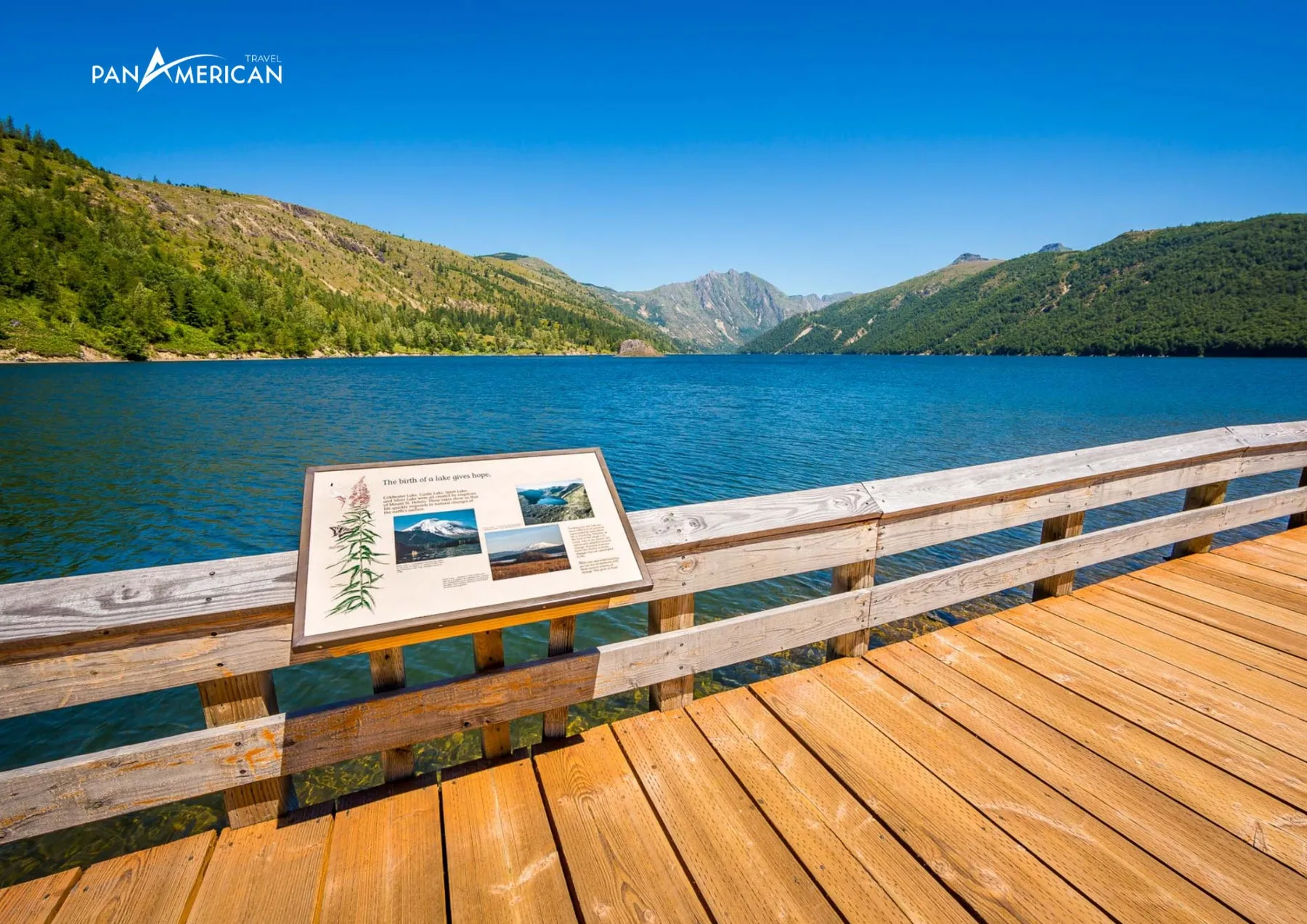
Coldwater Lake, a peaceful destination to relax and immerse yourself in nature.
At Coldwater Lake, you can participate in activities such as kayaking, fishing, swimming (in summer), and lakeside strolling. The area around the lake has many picnic areas and green lawns, ideal for families and groups of friends to play and camp.
Visiting Tips:
- Rent a kayak or paddleboard to explore the lake.
- Find a beautiful picnic spot by the lake and enjoy an outdoor meal.
- Swim in the lake in summer (pay attention to safety and follow regulations).
- Hike on the Birth of a Lake Trail to learn about the formation process of Coldwater Lake.
Mount Margaret Backcountry
Mount Margaret Backcountry wilderness area is a destination for adventurers and those who want to explore remote lands. This area has diverse terrain, from dense forests and meadows to rocky mountains and lakes.

Mount Margaret Backcountry, a paradise for those who love exploring and experiencing wild nature.
Mount Margaret Backcountry offers many long-distance hiking and overnight camping trails, providing opportunities to experience true wilderness. You will admire panoramic views of the crater, Spirit Lake, and the regenerating ecosystem from different perspectives. However, this area requires navigation skills and thorough preparation due to rugged terrain and low traffic.
Visiting Tips:
- Plan in detail and prepare sufficient equipment for long hikes and camping.
- Bring a topographic map, compass or GPS device, and know how to use them.
- Inform relatives or friends about your itinerary and route.
- Follow “Leave No Trace” principles to protect the wilderness environment.
Best Time to Visit Mount St. Helens?
Summer (June to September) is the ideal time to visit Mount St. Helens National Volcanic Monument. The weather is warm, dry, and sunny, perfect for outdoor activities such as hiking, kayaking, camping, and sightseeing. Roads and attractions are also more accessible in the summer.
However, summer is also the peak tourist season, so attractions may be more crowded and service prices may be higher. If you want to avoid crowds and save costs, spring (April – May) and autumn (October – November) are also good options. The weather in spring and autumn is cool and pleasant, and the natural scenery also offers unique beauty. In winter (December – March), the Mount St. Helens area often has heavy snowfall, and many roads and attractions may be closed or difficult to access.
Safety Tips for Exploring Mount St. Helens
Although Mount St. Helens is no longer as active as in 1980, the area is still a dormant volcano with potential hazards. Visitors need to follow these safety measures to ensure a safe and enjoyable trip:
- Monitor warnings: Check the U.S. National Park Service (NPS) website or visitor center for updates on volcano status, weather, and safety warnings.
- Stay on trails: Always stay on marked trails and avoid entering restricted areas.
- Prepare appropriate attire: Wear warm, waterproof clothing, hiking shoes or athletic shoes with good traction. Wear a hat, sunglasses, and use sunscreen.
- Bring enough water and snacks: Especially when hiking or participating in outdoor activities.
- Inform others: If you are hiking alone, inform relatives or friends about your itinerary and route.
- Be cautious of wildlife: Do not feed wildlife and maintain a safe distance.
- Follow monument regulations: Do not litter, do not make loud noises, and do not impact the natural environment.
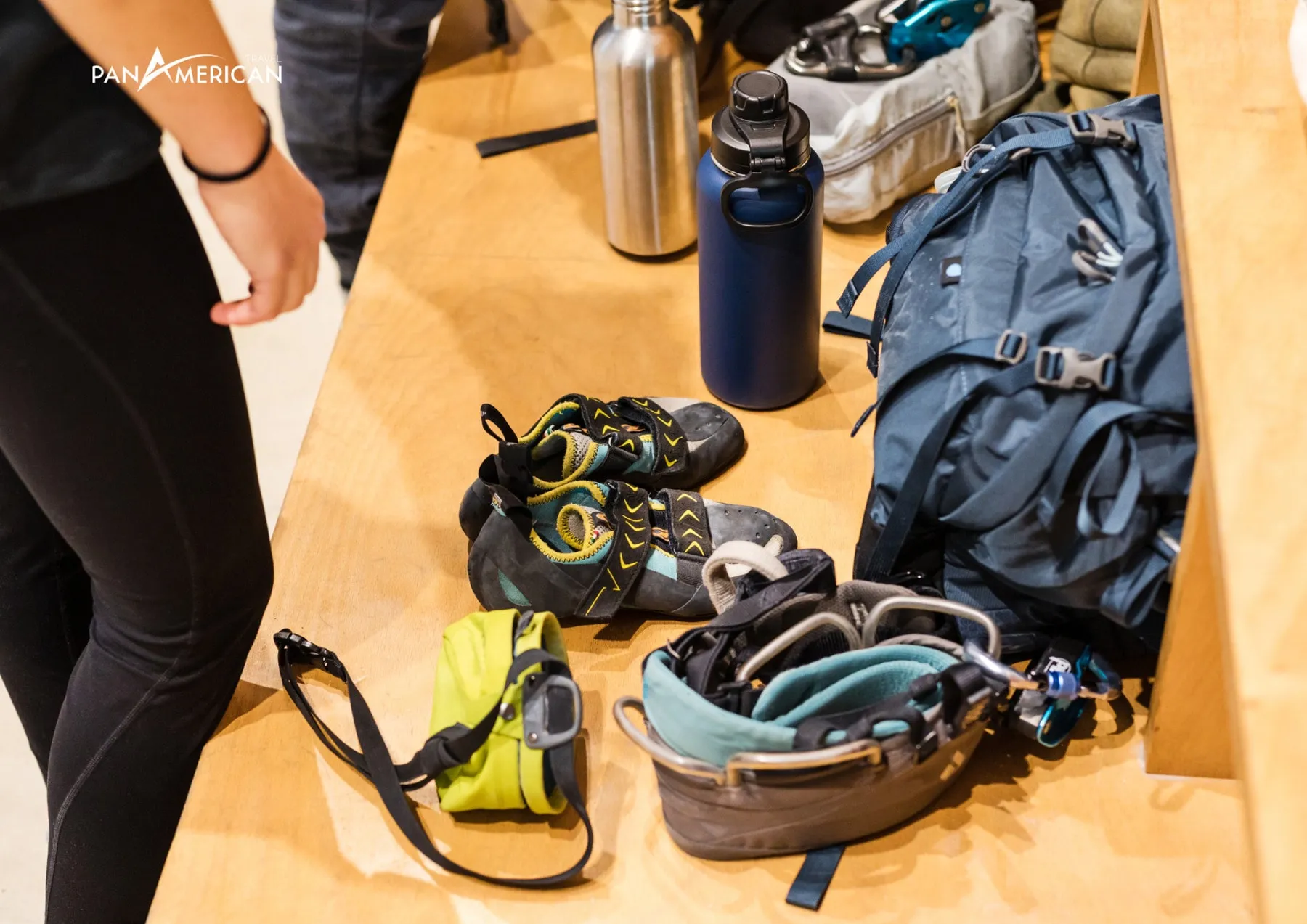
Equip yourself fully and follow safety rules for a complete visit to Mount St. Helens National Volcanic Monument.
Conclusion
Mount St. Helens National Volcanic Monument is a unique and fascinating tourist destination, offering diverse and memorable experiences. From admiring the majestic volcanic crater and exploring mysterious lava tubes to hiking in regenerating forests and relaxing by clear lakes, Mount St. Helens is sure to please every visitor. Plan your visit to Mount St. Helens National Volcanic Monument today to discover the unspoiled beauty and vibrant resilience of nature here!